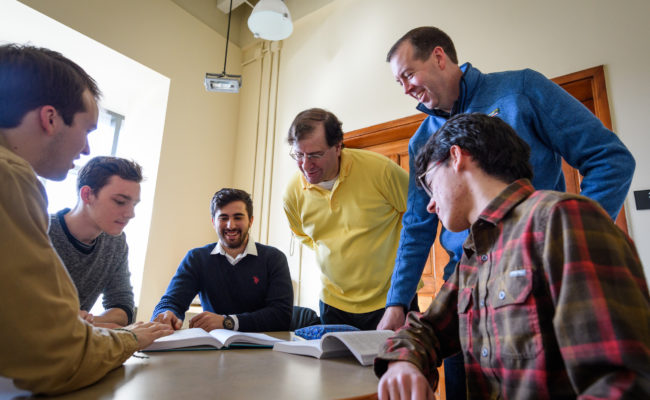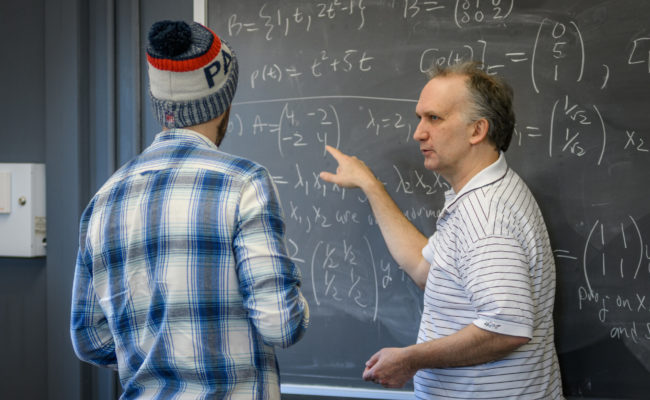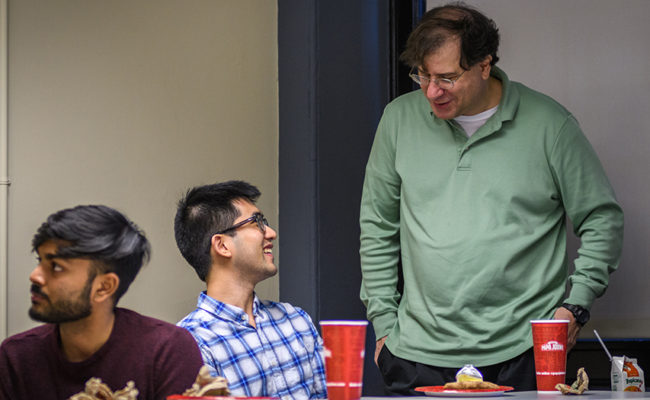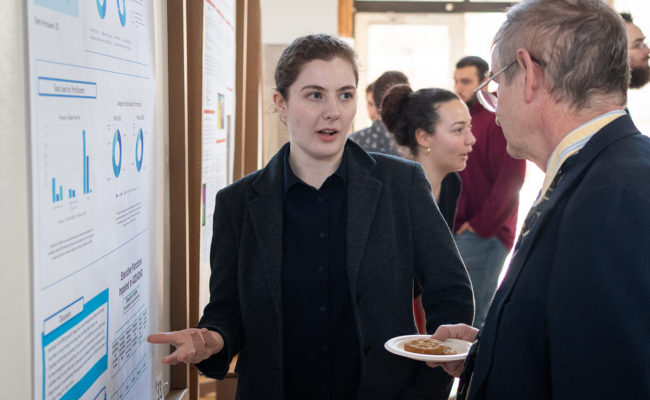Independent Research with a Faculty Mentor in Mathematics
Interested in pursuing an individual research project in mathematics? We encourage you to pursue independent research under the supervision of a faculty mentor. Student research activities include:
- Honors theses
- Inter- or intradisciplinary collaborative research on cutting-edge problems from a specific field of computer science
- Reading courses on advanced topics
- Qualified self-designed projects
Below, check out some of mathematics students’ most recent independent research projects.
Mathematics Student Projects
Mateo Gomez (now a 3-2 combined plan student at Columbia University), Sherman-Fairchild Fellow; summer research 2017
Mentor: Prof. Amir Aazami
This research project gave a rigorous introduction to understanding spaces that locally look just like our familiar space, but globally may be curved. The perfect example of this is earth: locally it looks flat, but globally it is a sphere. In fact, our very universe itself is assumed to have this local/global property, but being four-dimensional — three dimensions of space and one of time — we cannot “see” this as we can with Earth. Such spaces are called manifolds. The key question is: how does one do calculus on manifolds? How does one study their geometry, their curvature? E.g., the shortest distance between two points on earth can no longer be a straight line, because earth is curved, so how does one answer such questions now? The difficult task is that, given the “local/global” relationship that manifolds possess, one cannot rely solely on coordinates: one must think, so to speak, coordinate-independently. In fact, everything from the ground up has to be re-formulated: differentiability, vectors, the gradient, the Jacobian of a function, etc. All this needs to be understood before one can even begin to talk about geometry, or curvature, or gravity, or the universe and Einstein’s equations.
Mike Gaiewski (now a Ph.D. student in Applied Math at UConn), Sherman-Fairchild Fellow; summer research 2017 and 2018
Mentor: Prof. Jacqueline Dresch
One of the most important steps in mathematical modeling of a biological system is fitting the parameters of your model to experimental data. There is an extremely large number of different parameter estimation algorithms available, and an important question to ask is: what parameter estimation method should be used on my particular problem? In an attempt to answer this question in the context of modeling gene regulation, Michael developed and implemented novel parameter estimation algorithms based on the principles of evolution.
Andrew Mezzi, Sherman-Fairchild Fellow; summer research 2018
Mentor: Prof. Gideon Maschler
Andrew worked on a project that encompassed many different topics from functional analysis: infinite-dimensional linear algebra, operators, and applications of solutions to ordinary differential equations.
During the summer, Andrew was also exposed to a variety of internet resources and professional tools of the working mathematician, including the arXiv, MathSciNet, LaTeX and TeX-related editors, as well as the MathOverflow and StackExchange websites.
Emma Kirkman-Davis, summer reading course 2017
Tenzing Gurung, summer reading course 2017
Wenwen Shen, honors thesis 2016
Mentor: Prof. Gideon Maschler
Emma, Tenzing, and Wenwen all worked on topics in differential geometry. Their work focused on curves and surfaces, lengths on these, intrinsic and extrinsic curvature, and the relation between curvature and topology (i.e., global geometry, the Gauss-Bonnet Theorem).
Navid Al Hossain, Sherman-Fairchild Fellow; summer research 2016 and 2017
Regan Conrad, Sherman-Fairchild Fellow; summer research 2017 and 2018
Mentor: Prof. Jacqueline Dresch
Predicting the location of protein binding sites within a genome is a difficult task, but is an integral part of furthering our understanding of gene regulation. Traditional methods involve PWMs (position weight matrices), which rely on the underlying assumption that each nucleotide within a TF binding site is independent of the other nucleotides. More recently, models have been implemented which relax this assumption to include dependence on neighboring nucleotides (i.e. a string of contiguous nucleotides).
Navid’s project focused on analyzing the correlation between the frequency of binding sites within raw sequence data and the bioinformatically predicted ‘strength’ of these binding sites. His work has been instrumental in the experimental design and continued collaboration between the Dresch group in the Mathematics and Computer Science Department, the Drewell lab in Biology, and the Spratt lab in Chemistry.
Regan’s project focused on analyzing bioinformatic predictions of binding sites within core promoter regions from Drosophila melanogaster to investigate potential nucleotide dependencies and improve the predictive power of these algorithms.
Logan Bishop-Van Horn, directed study, spring 2016
Teodor Nicola-Antoniu, summer research 2016
Mentor: Prof. Jacqueline Dresch
Using raw data from microscope images in modeling gene expression levels presents the researcher with many challenges; one must be able to remove any extraneous information from the image and be able to compare images prepared and taken from different embryos on different days. For this reason, Logan and Teodor’s projects focused on creating a pipeline for processing these images, including noise and background subtraction, normalization, spatial registration, and extraction of quantitative levels of gene expression.
Trung Ngo (now an application developer at Morgan Stanley), honors thesis 2018
Mentor: Prof. Michael Satz
Can you imagine a set that is finite but impossible to practically count even with a supercomputer? One way to build such a set is to define it as a subset all permutations of the integers 1 through N. For example, our hard-to-count set may be all such permutations satisfying some constraint involving these integers and the position they’re in. Depending on the constraint, the hard-to-count set may not be particularly large, but the parent set (which has N! elements) may well be too large for an exhaustive check-and-count approach. Monte-Carlo Markov chain methods introduce randomness to estimate the sizes and other features of such complicated combinatorial sets. Trung Ngo applied four algorithms to one such counting problem. The algorithms were implemented in Python and tested and analyzed for performance, convergence, and accuracy.
Franklin Feingold (now a project manager at Stanford University), honors thesis 2015
Mentor: Prof. Gideon Maschler
In recent years, there have been multiple studies that use techniques in differential geometry to analyze brain MRIs. Franklin’s project focused on exploring some of the methods used and understanding how differential geometry can be used in modern-day medicine.
First-year students in the Diving into Research course, 2014-15
Mentor: Prof. Natalia Sternberg
Plasma televisions, plasma lights, the heat around the space shuttle and communication blackout caused by plasma, laser treatments in medicine, and production of microchips for computers are just a few applications of plasmas that became a big part of our lives. Students will learn about plasmas by developing and studying mathematical models that explain the experiments and help to obtain plasmas with certain properties.
Diving into Research
In addition to independent research projects, our department periodically provides opportunities for first-year and upper-class students to work in groups with faculty members on research projects through the course Diving into Research (MATH110, MATH 111). MATH110 Diving into Research is a year-long opportunity for first-year students to work in groups with faculty members on research projects.
Recent topics have included:
- Modeling re-entry communication blackout on the space shuttle caused by plasma
- Modeling gene regulation in a developing fruit fly embryo
Groups are limited to eight students. Students earn 0.5 credits each semester, and the full year is necessary to obtain credit. May be repeated as MATH111. Note: Neither MATH 110 nor MATH 111 count as credit towards the Math major.
A Sampling of Course Descriptions for Diving into Research
Plasma televisions, plasma lights, the heat around the space shuttle and communication blackout caused by plasma, laser treatments in medicine, and production of microchips for computers are just a few applications of plasmas that became a big part of our lives. Students will learn about plasmas by developing and studying mathematical models that explain the experiments and help to obtain plasmas with certain properties. (Instructor: N.Sternberg)
This course will introduce the idea of mathematically modeling gene regulation in a developing organism. Students will learn how mathematicians work with biologists to design simple experiments and derive equations to model gene expression. We will also explore some of the computational approaches currently being implemented in modern biology, including bioinformatics, data processing, and parameter estimation. This one-year course will be an interactive experience for students interested in learning more about the interface of mathematics, computer science, and molecular biology. (Instructor: J.Dresch)
Geometry is a branch of mathematics which closely relies on visual intuition. As such, parts of it are accessible even without obtaining extensive preliminary background, while still being deep and thought-provoking. In this seminar-style class, we explore the subject from a number of different perspectives, thus demonstrating its richness. Among the possible topics chosen are Projective and Differential Geometry, and symmetries and their relation to the mathematical concept of a group. Our guiding principle for these choices will be their accessibility to direct geometric intuition and imagination. The need for prior mathematical background will be kept at a minimum level. We will also be employing computer graphics and related software for visual exploration. The main purpose is to have fun while appreciating geometry. (Instructor: G.Maschler)





